Colgate-Palmolive-Peet
Continued from: Colgate and Palmolive
In 1928, Colgate and Palmolive-Peet merged to form Colgate-Palmolive-Peet. By combining their operations the new company became the third-largest soap producer in the United States, after Lever Brothers and Procter & Gamble (Fortune, 1936), with factories in Jersey City, New Jersey; Jeffersonville, Indiana; Milwaukee, Wisconsin; Berkeley, California; and Kansas City, Kansas.
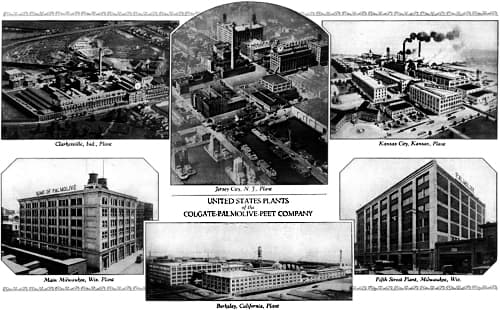
Above: American factories of Colgate-Palmolive-Peet.
Colgate-Palmolive-Peet also owned and/or operated plants in Toronto, Canada; Mexico City, Mexico; Sydney, Australia; Havana Cuba; and London, England. Its products were also made in Denmark, Sweden, Belgium, France, Germany, Italy, Argentina, and Brazil and were distributed throughout South America, Africa and Asia.
Charles S. Pearce
Palmolive-Peet was larger than Colgate at the time of the merger and its predsident, Charles Pearce, became the president of Colgate-Palmolive-Peet. The Colgate brothers acquiesced to this, apparently happy to have the company managed by someone younger with what looked like a keen business sense.
After the merger, Pearce set about making Colgate-Palmolive-Peet an even larger soap-and-food corporation. Options were taken out to merge Colgate-Palmolive-Peet with the Kraft-Phenix Cheese Corporation and the Hershey Chocolate Corporation but the 1929 stock market crash doomed the plan. Although this grand failed, the company continued to grow through other acquisitions.
In 1930, Colgate-Palmolive-Peet bought Kirkman & Son, Inc., a Brooklyn soap company established by John Kirkman [1801-1880] in 1837. The following year, it purchased the Omega Chemical Company with its controlling interest in Omega Ltd. of London, the Société Cadum of Paris – one of the largest soap manufacturers in France – the Société Cadum of Belgium, and factories in England and France. Other acquisitions included Binder & Ketels (1932), a soap manufacturing company based in Hamburg, Germany, and Compania Nacional de Perfumeria, Havana, Cuba (1933).
In 1930, Peace also moved the executive offices of Colgate-Palmolive-Peet into the newly completed Palmolive Building at 919 North Michigan Avenue, Chicago, which had begun construction before the merger, and he also listed the company on the New York Stock Exchange.
Depression
As the stock market crash of 1929 extended into the Great Depression the situation at Colgate-Palmolive-Peet became very grim. Its profits fell from nearly US$9 million in 1929 to just US$53,301 in 1932 (Fortune, 1936, p. 141) and there was a corresponding crash in its stock price.
Some of the blame for the fall in profits can be attributed to Felix Lowy [1888-1937], the vice-president in charge of sales and advertising who was heavily backed by Pearce. Lowy counted on a quick end to the downturn and to maintain the company’s soap sales, he cut prices and made purchasing agreements with sellers that reduced the company’s margins. Procter & Gamble on the other hand lost sales but maintained its margins and managed to earn a net profit of US$11 million in 1933 (Fortune, 1936, p. 139).
Lowy’s sales tactics alienated druggists who then began to push the products of other companies or their own private brands, so, by 1932, sales of Colgate-Palmolive-Peet products began to fall across the board (Fortune, 1936, p. 141) placing Colgate-Palmolive-peet in the unenviable position of experiencing falling sales and margins.
In 1933, the directors of Colgate-Palmolive-Peet acted to stem this intolerable situation. As mentioned earlier, Palmolive-Peet was a larger company than Colgate but its rapid growth had been accomplished through the sale of shares. Colgate on the other hand was largely owned by the Colgate family. This meant that the Colgate family owned 40% of the stock of Colgate-Palmolive-Peet compared to the 10% owned by the management headed by Pearce. It was therefore relatively easy for the Colgate brothers to implement a management change. Charles Pearce was effectively retired by being made chairman of the board and the presidency and management of the company was taken over by Bayard Colgate. Felix Lowy resigned, went to work for the Holeproof Hosiery Company in Milwaukee, and was replaced by Edward H. Little.
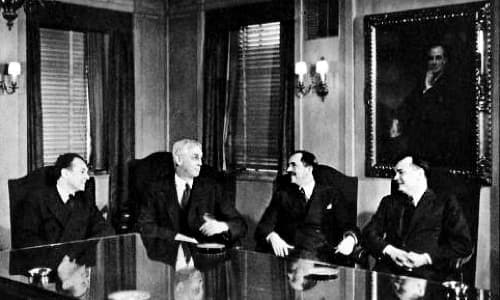
Above: 1936 S. Bayard Colgate (president and chairman of the executive committee), Russell B. Colgate [1873-1941], Henry A. Colgate [1890-1957] and Robert B. Colgate [1902-1973]
After the management change things began to improve. In 1933, profits were only US$373,389 but they rose to reach US$4,921,921 by 1938. By then, Little had become the president of the company, now headquartered in Jersey City. Bayard Colgate had moved the company headquarters there in 1934 after a two-storey extension to the building in Hudson Street was completed.
Products
Colgate-Palmolive-Peet’s general consumer product list included Colgate Ribbon Dental Cream, Palmolive Shaving Cream, Colgate Rapid Shave Cream, Octagon Laundry Soap, Crystal White Soap, Palmolive Complexion Soap, Super-Suds, Palmolive Beads, and Cashmere Bouquet Toilet Soap.

Above: c.1929 Colgate-Palmolive-Peet laundry soaps, toilet soaps, shaving creams, toothpastes and cosmetics.
A number of these products were in direct competition with each other; e.g., Palmolive Shaving Cream and Colgate Rapid Shave Cream; and Palmolive Complexion Soap and Cashmere Bouquet Toilet Soap. Despite this, production of these toiletries were maintained but a number of other lines disappeared or were rationalised. The Palmolive and Fanchon cosmetic ranges, previously owned by Palmolive, disappeared with the exception of Palmolive Face Powder which was available in some places up until the Second World War; the Lournay line, also started by Palmolive, underwent changes; the Seventeen line, previously owned by Colgate, was hived off; the Pompeian range bought by Colgate in 1927 was sold; and a new Cashmere Bouquet range was introduced.
Cashmere Bouquet
In February, 1933, one month before Charles Pearce was removed from office, Colgate-Palmolive-Peet introduced an expanded Cashmere Bouquet range adding a Cleansing Cream, Astringent, Tissue Cream, Foundation Cream, Hand Lotion, Lipstick and Cream Rouge. This new line appears to have been an attempt by Colgate-Palmolive-Peet to rationalise its Colgate and Palmolive cosmetic ranges which overlapped and were aimed at the same market. It was packaged in green, a favoured Palmolive colour.
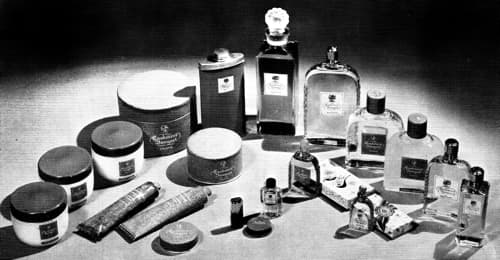
Above: 1933 Cashmere Bouquet range which included Dusting Powder, Face Powder, Talcum Powder, Foundation Cream, Cleansing Cream, Tissue Cream, Toilet Water, Astringent, Brilliantine, Hand Lotion, Cream Rouge, Lipstick and Perfume. Jars were white with green lids and with green and white labels; powder boxes were in green with white labelling.
Colgate-Palmolive-Peet relied on the popularity of Cashmere Bouquet Soap to generate sales of other products in the range. To help with this, the company reduced the price of the soap from 25¢ to 10¢ in 1934 which brought it within the price range of other products in the line.
In 1935, with the company now managed by Bayard Colgate, the range was repackaged in pink, white and blue containers for the North American market. This was more feminine and in better agreement with the packaging for Cashmere Bouquet Soap. The new packaging was awarded first prize in the 1936 ‘5 & 10’ Packaging Exhibition in New York.

Above: 1936 Cashmere Bouquet range in new packaging. Repackaged items were Cashmere Bouquet Toilet Soap, Face Powder, Talc Powder, Lipstick, Hand Lotion, Vanishing Cream, Cold Cream, Perfume and Toilet Water.
Cashmere Bouquet (Australia)
Colgate-Palmolive-Peet did not introduce the new Cashmere Bouquet range into many other countries in the 1930s but it was made available in Canada, Australia and New Zealand.
Cashmere Bouquet Perfume and Soap had been available in Australia from the 1883 at the latest. When Colgate-Palmolive-Peet introduced the new Cashmere Bouquet range in 1933 the company took advantage of the manufacturing plant that Palmolive had established in Balmain, Sydney in 1923 and introduced the entire range into Australia in 1933.

Above: 1933 From the left: Cashmere Bouquet Cleansing Cream, Liquid Brilliantine, Perfume, and Concrete Brilliantine (Australia).
On a population basis the Cashmere Bouquet range was more successful in Australia and New Zealand than it was in the United States and Canada but there were a number of differences in the way the line was handled in Australia and New Zealand compared to North America. Colgate-Palmolive-Peet subsidiaries were allowed a good deal of autonomy from the parent company and the Australian managers put this independence to good effect.
In Australia, the line did not undergo the packaging change that took place in the United States and the shade ranges were different; e.g, in 1934, Cashmere Bouquet Face Powder came in Naturelle, Dark Rachel, Light Rachel, Beige, and Peach Rachel in the United States but was sold in White, Flesh, Naturelle, Rachel, and Dark Rachel shades in Australia.
Seventeen
Colgate had debuted the Seventeen fragrance in 1928, the year it merged with Palmolive-Peet. By 1930, Colgate-Palmolive-Peet was marketing Seventeen Perfume, Toilet Water, Sachet, Talcum Powder, Dusting Powder, Face Powder, Compact Rouge, and Brilliantine, with Seventeen Lipstick added by 1931.
Seventeen Two-Tone Powder: “[L]ends your skin the delicate transparency of youth. Ingredients of two weights are blended. The heavier clings closely to the skin. The lighter weight, on the surface, seems to take on a lighter color tone.” Shades: White, Ivory, Naturelle, Champagne, and Rachel.
Seventeen Lipstick: “You will be delighted with the soft natural effect—only possible with youth-tone shades.” Shades: Light, Medium and Dark.
Seventeen Rouge: “[S]imulate the elusive color tones of naturally youthful skin.” Five shades.
In 1932, Colgate-Palmolive-Peet created Maison Jeurelle, Inc. which then took over the Seventeen range and expanded it to include Seventeen Mascara and Eye Shadow as well as skin-care cosmetics such as Seventeen Cleansing Cream, Tissue Cream, Foundation Cream, and Skin Tonic Cream. A nail range was added in 1933 and Seventeen Suntan Oil in 1937.
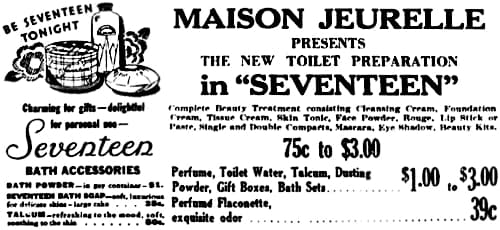
Above: 1932 Maison Jeurelle Seventeen.
In 1935, Maison Jeurelle incorporated and this may be when it became separated from Colgate-Palmolive-Peet. After the incorporation the company moved its general offices from New York to Chicago and opened a factory there at 3529 West 47th Street.
Along with expanding the Seventeen range, Maison Jeurelle also introduced a number of new limited-edition fragrances along with some novel containers.
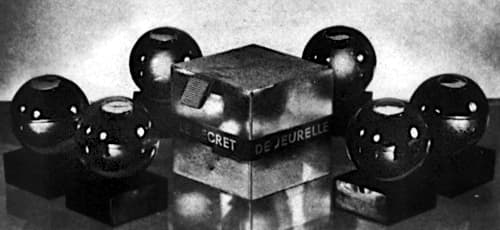
Above: 1933 Maison Jeurelle Parfum Spheres. These were tiny clear glass globes containing 1⅛ drams of perfume mounted on plastic ebony-like bases. The spheres retained the perfume until it was shaken out.
In 1936, the company established Maison Jeurelle-Seventeen, Inc. as a subsidiary to separate the Seventeen range from its other lines. Both companies were bought by the Emerson Drug Company in 1946 but Emerson sold both to the Seventeen subsidiary in 1948 which then operated out of New York as Seventeen, Inc. The new owners do not appear to have been successful and my last references to the line dates from the early 1950s.
Lournay (Australia)
The Lournay cosmetic range had been established by Palmolive in 1920 but appears to have been discontinued in the United States after 1930. It was resurrected a number of times without success the notable exception to this being its production in Australia.
See also: Palmolive
Lournay Toilet Soap had been available in Australia in the early 1930s but it was not until 1940 that the Australian subsidiary of Colgate-Palmolive-Peet, Colgate Palmolive Pty. Ltd., introduced a range of Lournay cosmetics into the market in Australia and New Zealand. It was packaged in cream containers marked with a distinctive red triangle and the Lournay name.

Above: Lournay cosmetics manufactured in Australia. Some of these date from after 1945.
The Australia subsidiary appears to have taken advantage of the trade restrictions created by the Second World War which resulted in shortages. Lournay was manufactured locally in the Balmain factory in Sydney and was aimed in the middle range of the Australian cosmetic market with most products almost double the price of Cashmere Bouquet lines.
Skin-care
The Australian Lournay range included all the cosmetics needed for a daily skin-care routine along with products for special problems such as blackheads, freckles and an uneven tan.
Lournay Cleansing Cream: “A fine, smooth cream specially created to suit dry or normal skin, to melt make-up and thoroughly cleanse the pores.”
Lournay Cleansing Lotion: “This soothing, neutralized cleanser is most suitable to the oily type of skin, or where a quick change of make-up is required.”
Lournay Nourishing Cream: “[A] gentle lubricating cream suitable for all types of skin. To build up tissue cells, counteract flabbiness and keep the skin fresh and youthful.”
Lournay Astringent lotion: “[F]or daily use, is designed to reduce excessive oiliness and refine open pores.”
Lournay Skin Vitalizer: “[A] particularly mild astringent for the dry and sensitive skin. Braces and refreshes the skin before make-up.”
Lournay Complexion Balm: “[S]oothes and protects the sensitive skin. Particularly valuable to guard the skin against harsh, outdoor conditions and for alleviating roughened or chafed skin.”
Lournay Wrinkle Cream: “[S]cientifically prepared to help the ageing skin. This cream strengthens relaxed muscles, smoothes out lines and wrinkles and generally rejuvenates the skin.”
Lournay Beauty Mask: “[B]rings new loveliness overnight to the coarse-textured skin which has a tendency toward open pores and blemishes.”
Lournay Blackhead Cream: “[R]emoves and corrects even the most obstinate cases of blackhead condition and is also beneficial in cases of excessive oiliness.”
Lournay Bleach and Freckle Cream: “If your suntan has faded to a patchy brown or your freckles are unsightly, this mild, safe bleach cream will restore the skin to an even, natural tone.”
Lournay Hand Balm: “[R]estores the true skin texture of busy hands.”
Lournay provided suggestions for daily skin care treatments for Normal, Dry, Oily, and Combination skin types. These all began in the morning with a wash with Lournay Beauty Soap – to be expected from a soap company – and used Lournay Cleansing Cream and Lournay Nourishing Cream at night. I include the routine for Combination Skin as an example:
To Cleanse: Before going to bed, use a generous quantity of Lournay Cleansing Cream, massaged into the skin. After removing cream with tissue, thoroughly was the face with Lournay Beauty Soap. for day cleansing on this type of skin use Lournay Cleansing Lotion
To Nourish: When the skin is absolutely clean, pat Lournay Nourishing Cream into face and neck until well absorbed, paying particular attention to the dry areas. Remove surplus cream with tissue. It is advisable to apply Lournay Beauty Mask on the oily areas every second night and over the entire face once weekly.
To Stimulate: Morning care is particularly important to the “combination” type of skin. Wash with Lournay Beauty Soap, then brace your skin with Lournay Astringent Lotion, applied with a patting movement on a pad of cotton-wool. Where you have greasy areas apply Astringent every day, but where the skin is normal or dry, apply lightly every second day. You will find this treatment will even up your skin texture.(‘Lasting loveliness with Lournay,’ c.1940, p. 7)
Like other beauty routines of this period, massage was considered an important part of any treatment and Lournay provided its clients with massage instructions.

Above: Lournay massage movements.
Make-up
Lournay’s Australian range contained two different foundations: Lournay Foundation Film for normal and dry skin types; and Lournay Liquid Powder Base for women with an oiler skin. After foundation came Lournay Face Powder produced in the same shades as both foundations – Gipsytan, Sunkissed, Peachbloom, Roseglow, Dawn Pink, Magnolia, and Frangipani.
Lournay Foundation Film: “This delicate cream forms a protective film, yet does not mask the natural texture of the skin.”
Lournay Liquid Powder Base: “This pearly smooth foundation counteracts the tendency to ‘shine’ which is characteristic of oily type skin.”
Lournay Face Powder: “[I]s sifted to a light-as-air consistency that makes it lie smoothly and invisibly on your face.”
The Lournay make-up range also included a cream and compressed powder rouge, lipstick, eye shadow, eyebrow pencil, and mascara. Both types of rouge came in the same shades as the lipstick – Scarlett, Hibiscus, Burgundy, Marigold, Sunbronze, Rendezvous, Red Velvet, and Petunia.
Lournay Rouge: “If your skin is inclined to be oily, we offer Lournay Powder Rouge but for the dry skin, Lournay Cream Rouge is more suitable.”
Lournay Lipstick: “Has a special oil base that keeps your lips dewy soft yet its colour is so satisfyingly indelible.”
Lournay Mascara: “Your eyes will gain depth and glamour.” Shades: Black , Brown, and Blue.
Lournay Eye-Shadow: “Dramatize the colour of your eyes.” Shades: Almond Green, Orchid, Lavender Blue, Dark Blue, Iridescent Blue, Grey, and Golden Brown.
Lournay Eyebrow Pencil: “Intensify the natural characteristics of your eyebrows.” Shades: Brown, and Black.
Clients could select suitable colours using a colour-coordination chart based on a woman’s hair and eye colour.
Other products in the range were Lournay Beauty Soap, Brilliantine, Dusting Powder, Talc, and Perfume.
Post-war
There were only a few additions to Colgate-Palmolive-Peet’s personal-care products in the United States in the decade after the Second World War, with most of the additions being toiletries.

Above: 1950 Cosmetics and toiletries from Colgate-Palmolive-Peet.
Veto
Until 1945, Colgate-Palmolive-Peet relied on Cashmere Bouquet Talcum Powder for deodorant sales when the company introduced Veto Cream Deodorant. It was formulated with aluminium sulphamate (aluminum sufamate) so it acted as an antiperspirant as well as a deodorant. In 1952, the company followed this with Veto Spray Deodorant, packaged in a plastic squeeze container very similar to the one developed by Dr. Jules Bernard Montenier [1895-1962] for Stopette in 1948.
See also: Stopette
Lustre-Creme
Colgate-Palmolive-Peet had been selling its Halo Shampoo from 1938 but it added Lustre-Creme Shampoo to its range after it acquired Kay Daumit, Inc. in 1947. It kept the blue packaging but added a tube version to the original jar, then followed with Lustre-Creme Lotion Shampoo in a white bottle in 1952.
Lustre-Creme: “The lanolin-blessed cream shampoo that washes new sheen, fragrance, softness into your hair—leaves it easy to curl and wave!”
Cashmere Bouquet
Colgate-Palmolive-Peet continued to cut the price of Cashmere Bouquet Soap before introducing the Cashmere Bouquet Beauty Bar in 1952.
Cashmere Bouquet Beauty Bar: “[D]eveloped especially for gentle, effective complexion care . . . does more for your skin than any toilet soap you have ever used can possibly do!”
I have only been able to locate a few new developments in the American Cashmere Bouquet range through to 1953.
In 1947, Colgate-Palmolive-Peet added Cashmere Bouquet Beau Cake, a pan-cake type of make-up emulating the highly successful product introduced by Max Factor in 1938. A novel feature of Beau Cake was the moisture-proof compartment built into the centre of the cake to hold the sponge applicator.
Cashmere Bouquet Beau Cake: “[I]mpart glamorous, smooth-as-silk finish to your skin; give it radiant young color. Tiny blemishes fade from sight, and the finish lasts for hours and hours.” Shades: Rose Brunette, Cream Rose, Golden Tan, Natural Tan, Rachel, and Rose Tan.
See also: Pan-Cake Make-up
In 1948, Colgate-Palmolive-Peet also added a new Cashmere Bouquet Hand Lotion (with lanolin), with a Push-Kap dispenser added to the container in 1950, followed with a pump-pack dispenser in 1953.
Cashmere Bouquet Hand Lotion: “This fast-drying lotion that softens like a cream has already done its wonderful work. Not a trace of stickiness or tackiness. Your hand feels smooth, is excitingly fragrant, exceedingly soft to the touch.“
Colgate-Palmolive-Peet did very little to promote the complete Cashmere Bouquet line in the United States, with most Cashmere Bouquet advertisements being for Cashmere Bouquet Soap, Talcum Powder or Face Powder. This changed in the 1950s when the company began a series of advertisements for Cashmere Bouquet Lipsticks. The probable reason for this change was the arrival of Hazel Bishop Lasting Lipstick in 1950. Lasting Lipstick set off the American ‘Lipstick Wars’ of the 1950s which bought lipsticks into greater focus in the American market in the 1950s.
See also: Lipstick Wars
In 1950, Cashmere Bouquet Lipstick came in eight shades – Pink Plum, Autumn Wine, Cherry Rose, Sparking Red, Medium, Dark Red, Tangerine and Natural. The company then introduced a range of new formulations starting with French Type Non-Smear Lipstick (1952), also in eight shades, then progressing through Indelible-Type Lipstick (1954) to Inner Glow Lipstick (1956) in Rhythm-in-Pink, Pink Plum, Look-Out Red, Pink-a-Boo, Tropic Sun, Peach-of-a-Pink, and Coral shades. None of these appear to have made much an impression and Colgate-Palmolive stopped advertising Cashmere Bouquet lipsticks by the end of the decade.
Lournay (Australia)
The Australian subsidiary of Colgate-Palmolive-Peet continued to manufacture Lournay products there after the Second World War. New shades were added to Lournay face powder, lipsticks and rouges and the company introduced Lournay Film Finish (1947), a new cream compact make-up, and a semi-fluid foundation called Wonder-Tone (1952) for women with dry or normal skin types.
Lournay Film Finish Cake Make-up: “It goes on so evenly and easily, giving the skin a silken smoothness that needs no retouching . . . not even if you dance, surf, or play in the sun.” Shades: Gossamer, Fragile, Illusion, and Tawny.
Lournay Wonder-Tone Foundation: “It is neither liquid or cream, but an in-between that blends smoothly and evenly.” Shades: Peach, and Pearl.
Cashmere Bouquet (Australia)
Like Lournay, the Cashmere Bouquet range also got more attention in Australia than it did in the United States. Its product range was very similar to that of Lournay and it also made allowances for Normal, Dry, Oily and Patchy (Combination) skin types.
Skin-care
In 1946, the Australian Cashmere-Bouquet skin-care range included the following:
Cashmere Bouquet Cleansing Cream: “[H]as been specially prepared to suit dry or normal skin. It replenishes moisture as it cleanses deep into the pores, melting away cosmetic dyes.”
Cashmere Bouquet Cleansing Milk: “[I]s the perfect fluid cleanser for oily skin. Effectively melts cosmetic dyes and thoroughly removes grime and dust. May be used for all types of skin when a quick make-up change is desired as it leaves no excess grease.”
Cashmere Bouquet Tissue Cream: “[W]ith special penetrating qualities to nourish the tissues, strengthen muscle fibres and smooth out fatigue lines. Keeps the skin smooth and firm.”
Cashmere Bouquet Skin Tonic Astringent: “[I]s a stimulating tonic that is safe for even the most sensitive skin. Refines the pores, corrects excessive oiliness and is an excellent bracer before make-up.”
Cashmere Bouquet Skin Lotion: “A satin-smooth lotion for regular use to neutralise oiliness and soothe and protect the skin. An ideal preparation to keep the hands soft and lovely.”
Cashmere Bouquet Blackhead Cream: “This cream may be safely used for all types of blackheads and excessively oily condition.”
Like Lournay, all the skin-care routines included soap. The routine for Patchy (Combination) is included as an example:
Night Care: Generously smooth Cashmere Bouquet Cleansing Cream with the fingertips and gently massage in from base of neck, cheeks, nose and forehead. Wipe off with tissues. Wash face with lukewarm water using Cashmere Bouquet Soap. Rinse with cold water. Pat Tissue Cream well into the neck and face, using upward and outward movements. Leave cream on skin for fifteen minutes then wipe off excess with tissues. Morning Care: Wash face in lukewarm water with Cashmere Bouquet Soap. Rinse with cold water. Pat Cashmere Bouquet Skin Tonic Astringent freely on nose and chin every day but apply to cheeks and forehead every second day. (Apply Astringent on cotton wool pad moistened with cold water.)
(‘Commonsense in cosmetics,’ c.1946, p. 5)
Make-up
By 1946, the Australian Cashmere bouquet range included three foundations selected by skin type all in the same four shades – Rachel, Pêche, Sungold, and Hawaiian Tan.
Cashmere Bouquet Complexion Lotion: “A powder-matching foundation specially prepared for normal or semi-oily skins. Gives a beautiful soft smooth finish.”
Cashmere Bouquet Foundation Cream: “A petal-soft cream that is the perfect powder base for dry skin.”
Cashmere Bouquet Foundation Lotion: “The perfect powder base for oily skin. Gives a lovely smooth matt finish which conceals blemishes and freckles. Flattering to the skin for evening wear when used for face, neck, arms and shoulders.”
Along with foundations were all the usual make-up lines most of which appear to be available in a wider range of shades than their American counterparts. Like the Lournay line, colours were selected according to hair and eye colour.
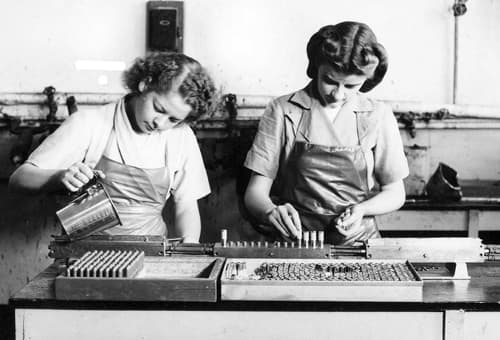
Above: 1948 Making lipsticks in the Balmain factory, Sydney.
Cashmere Bouquet Face Powder: “Silk-sifted to fairy softness in shades that blend very beautifully with the natural tone of your complexion.” Shades: Rachel, Dark Rachel, Pêche, Sungold, Hawaiian Tan (Light and Dark), Naturelle and White.
Cashmere Bouquet Lipstick: “Contains just enough oil to keep the lips soft and dewy. In thrilling shades to match Cashmere Bouquet Rouge.” Shades: Dark, Sungold, Hawaiian Tan, Tangerine, Tango, Two-Tone, Light, Medium, Signal Red, Royal Red, Orchid Red, Light Cyclamen, and Dark Cyclamen.
Cashmere Bouquet Rouge: “Compact Rouge and Creme Rouge (with an olive oil base). In dramatic and unusual modern shades.” Shades: Dark, Sungold, Hawaiian Tan, Tangerine, Tango Blonde, Light, Medium, Flame, Tango Brunette, Signal Red, Royal Red, Orchid Red, Light Cyclamen, and Dark Cyclamen.
Eye make-up consisted of: Brown, Back, and Blue Mascara; Black, and Brown Eyebrow Pencils; and Brown, Green , Blue, Silvery Blue, Mauve, and Gray Eye Shadow.
After Colgate-Palmolive-Peet introduced Cashmere Bouquet Beau Cake in the United States a similar product was added to the range in Australia in 1949. However, there it was manufactured as a whole cake without the sponge insert and consequently referred to simply as Cashmere Bouquet Cake Make-up. It also came in a more limited range of shades only debuting in Cream, Peach, and Tan.
In the 1950s Palmolive-Peet added new shades of make-up to the Australian Cashmere Bouquet range before introducing Look Alive Fluid Foundation in 1957.
Cashmere Bouquet Look Alive Fluid Foundation: “[K]eep your beauty excitingly vibrant under and light at any hour. It’s the day-time, night-time make-up you’ll go on using for life.” Shades: Natural Tint, Medium Tint, Rose Tint, and Tropic Tint.
Colgate-Palmolive
In 1953, Colgate-Palmolive-Peet underwent a structural change. The company amalgamated its international businesses into Colgate-Palmolive International, Inc., and separated them from the company’s domestic operations, now renamed as Colgate-Palmolive, Inc.
This is where my interest in the company largely ends. It continued to manufacture cosmetics but its primary focus was now in toothpastes and other toiletries, laundry products and other household cleaners, all products that it could sell in sufficient numbers to offset the increasing costs associated with mass marketing, particularly in the expensive medium of television.

Above:1968 Colgate-Palmolive heath, beauty and cleaning products.
In later years, Colgate-Palmolive expanded into areas such as food, medical products, sporting goods and pet foods, all through acquisitions. Amongst the many acquisitions was Helena Rubinstein which Colgate-Palmolive bought in 1973. The purchase did not prove to be successful and the loss-making concern was sold in 1980 for a fraction of its purchase price.
Also see: Helena Rubinstein (post 1945)
Timeline
| 1928 | Colgate merges with Palmolive-Peet to form Colgate-Palmolive-Peet. |
| 1929 | Palmolive Building opened in Chicago. |
| 1930 | Executive offices moved to the Palmolive Building in Chicago. Pompeian Manufacturing Company sold. Kirkman & Son company bought. Omega Chemical Company acquired. New Products: Seventeen line. |
| 1932 | Palmolive G.m.b.H merges with Binder & Ketels A.G. to form Palmolive-Binder & Ketels G.m.b.H. Maison Jeurelle founded. |
| 1933 | Compania Nacional de Perfumeria, Havana purchased. |
| 1934 | Colgate-Palmolive-Peet headquarters moved from Chicago to Jersey City. |
| 1935 | Maison Jeurelle incorporates; moves to Chicago. |
| 1938 | New Products: Halo Shampoo. |
| 1945 | New Products: Veto Cream Deodorant. |
| 1947 | Kay Daumit Company bought. New Products: Cashmere Bouquet Beau Cake; and Lournay Film Finish (Australia). |
| 1948 | New Products: Cashmere Bouquet Hand Lotion. |
| 1951 | New factory opened in Kansas City. |
| 1952 | New Products: Palmolive Rapid Shave; Veto Spray Deodorant; Lustre-Creme Lotion; Cashmere Bouquet Beauty Bar; and Lournay Wonder-tone (Australia). |
| 1953 | Colgate-Palmolive-Peet renamed Colgate-Palmolive. Colgate-Palmolive International established. New Products: Lustre-Creme Lotion Shampoo. |
| 1956 | Corporate headquarters moved from Jersey City to the Colgate-Palmolive building in New York City. |
| 1957 | Sales agreement to distribute Vaseline products ends. New Products: Cashmere Bouquet Look Alive Fluid Foundation (Australia). |
| 1959 | Wildroot Company purchased. |
| 1973 | Helena Rubinstein bought. |
| 1980 | Helena Rubinstein sold to Albi Enterprises. |
| 1992 | Mennen Company acquired. |
First Posted: 8th February 2021
Last Update: 14th April 2023
Sources
The American Perfumer & Essential Oil Review. (1906-1955). New York: Robbins Perfumer Co. [etc.].
Colgate-Palmolive Pty. Ltd. (c.1940). Lasting loveliness with Lournay [Booklet]. Sydney: Author.
Colgate-Palmolive Pty. Ltd. (c.1946). Commonsense in Cosmetics [Booklet]. Sydney: Author.
Colgate-Palmolive-Peet. Annual Reports 1933-1953.
Colgate-Palmolive-Peet. (1936). Fortune, XIII(4). 120-125, 138, 142-142, 148.
Hardin, S. T. (1959). The Colgate story. New York: Vantage Press, Inc.
How Colgate sells to 373,000 outlets. (1939). The American Perfumer, August, 31-35.
How Colgate grew. (1948). The American Perfumer and Essential Oil Review, September, 229-231.

Charles Sumner Pearce [1877-1965] late in life.

Palmolive Building, 919 North Michigan Avenue, Chicago, built by Holabird & Root.

1930 Seventeen.
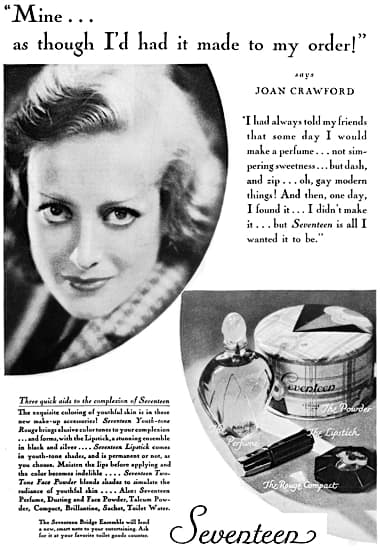
1931 Seventeen.
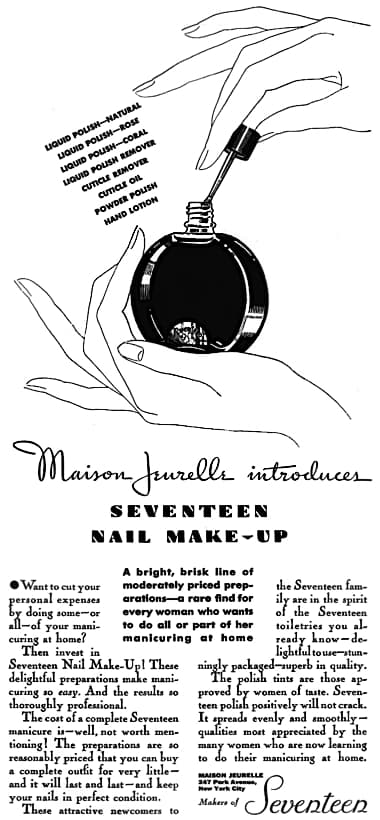
1933 Maison Jeurelle Nail Make-up.
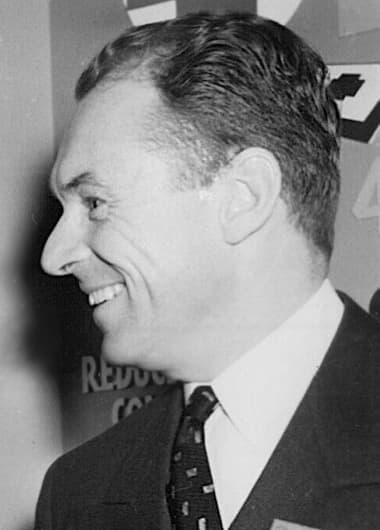
Samuel Bayard Colgate [1898–1963]. He took over the presidency in 1933 after the management change.
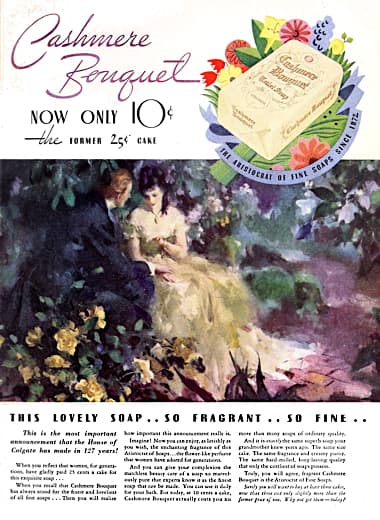
1934 Cashmere Bouquet.
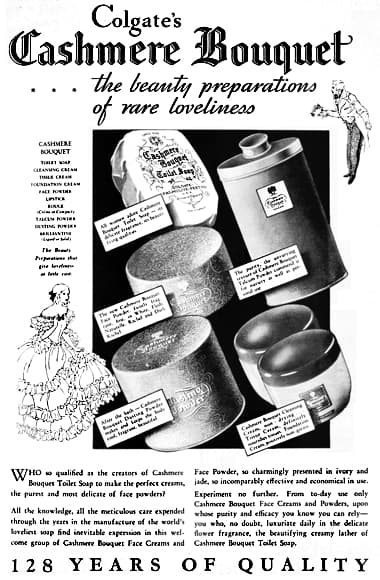
1934 Cashmere Bouquet (Australia).

The ten-story office building at 105 Hudson Street, Jersey City with two-storey extension. The building was the headquarters of Colgate & Company between 1910-1930, and of Colgate-Palmolive-Peet between 1934-1956 (Library of Congress).
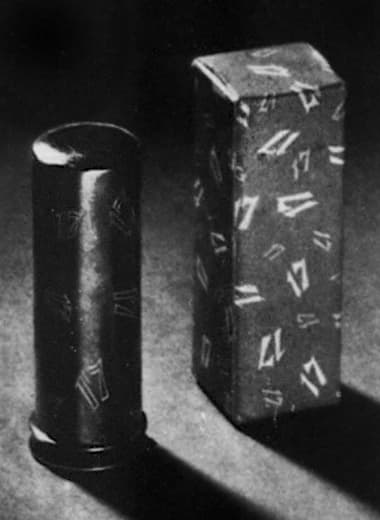
1937 Seventeen Lipstick.
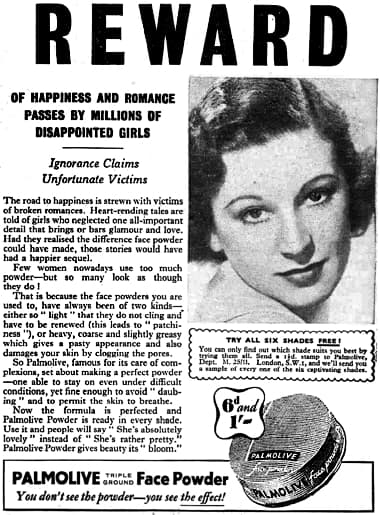
1937 Palmolive Face Powder (Britain).

1938 Cashmere Bouquet (Australia).
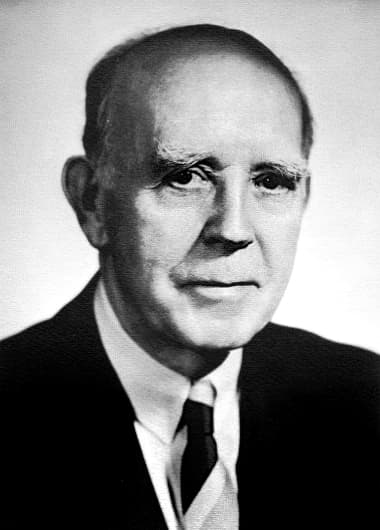
Edward Herman Little [1881-1981] in his later years. He became president of the company in 1938.

1941 Lournay cosmetics (Australia).

1941 Cashmere Bouquet Colourfast Lipstick (Australia).
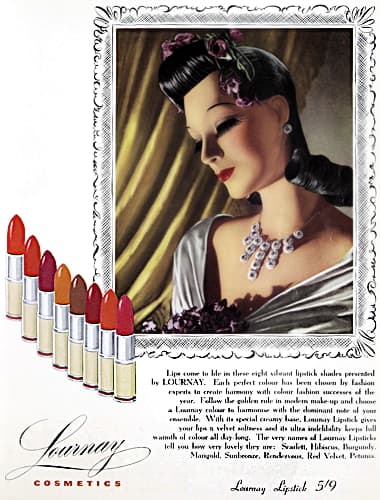
1941 Lournay lipsticks (Australia).
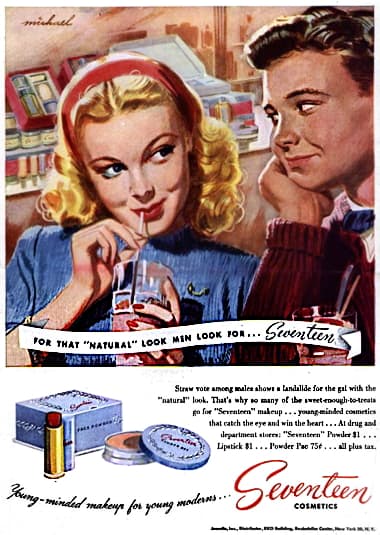
1947 Seventeen Cosmetics no longer part of Colgate-Palmolive-Peet..

1947 Cashmere Bouquet Beau Cake.

1948 Lustre-Creme.

1949 Veto Cream Deodorant.
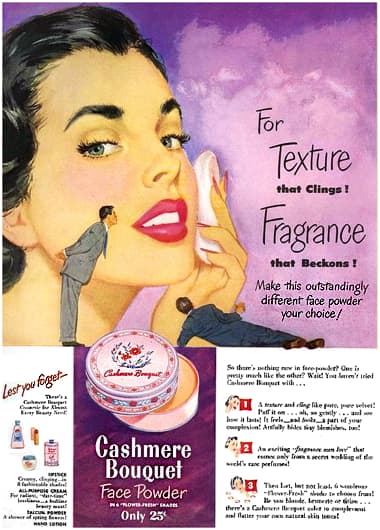
1950 Cashmere Bouquet Face Powder.
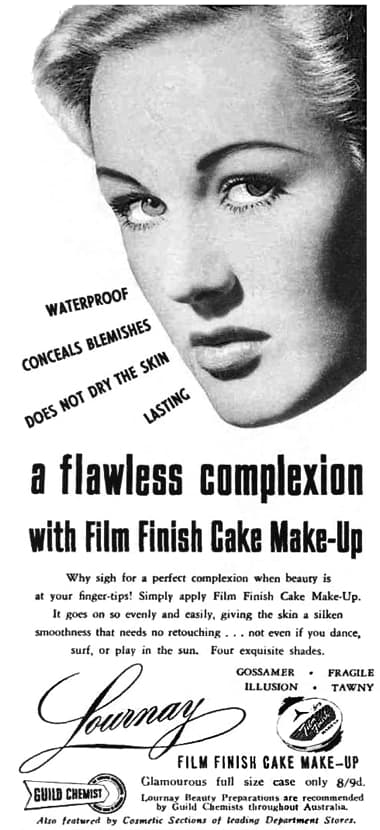
1950 Lournay Film Finish (Australia).
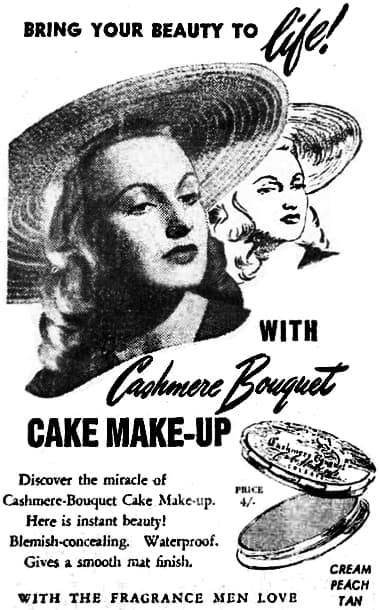
1950 Cashmere Bouquet Cake Make-up (Australia).
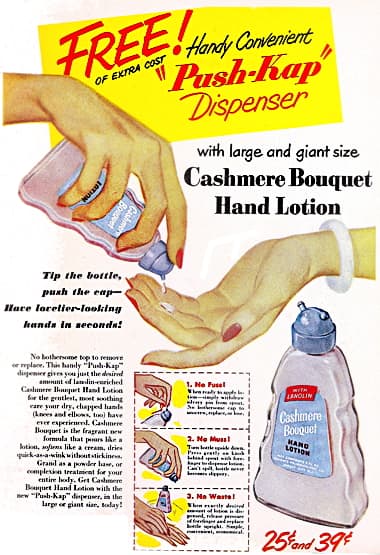
1950 Cashmere Bouquet Hand Lotion in Push-Kap dispenser.
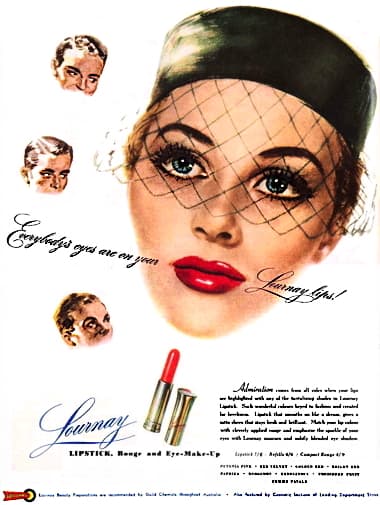
1951 Lournay Lipstick (Australia).

1952 Colgate-Palmolive-Peet cosmetics and toiletries.
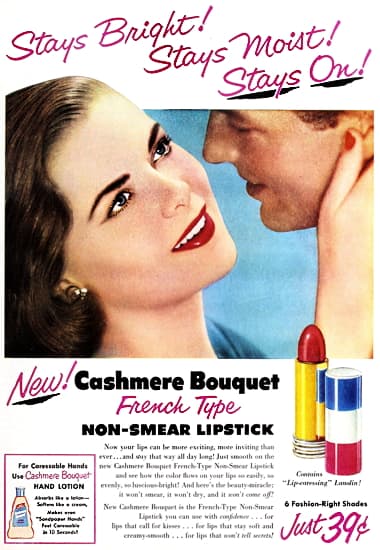
1952 Cashmere Bouquet French Type Non Smear Lipstick.
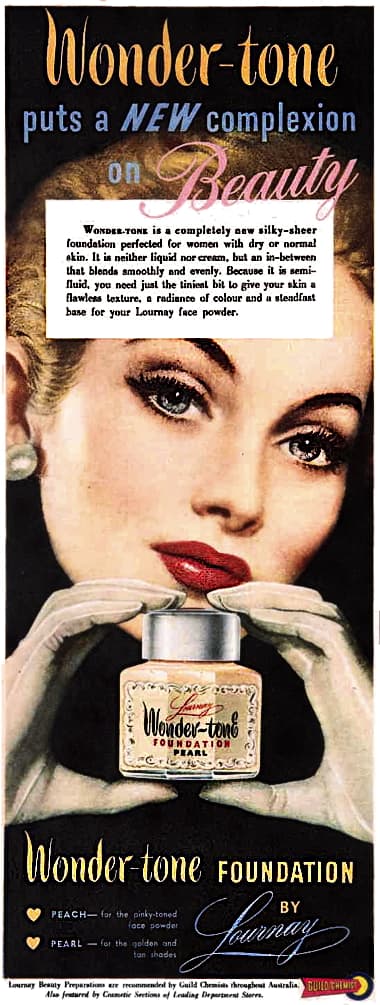
1952 Lournay Wonder-tone (Australia).
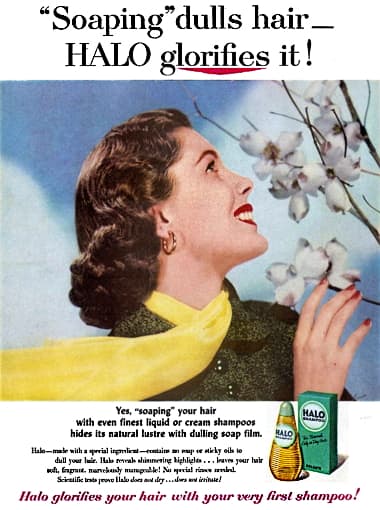
1953 Halo Shampoo.
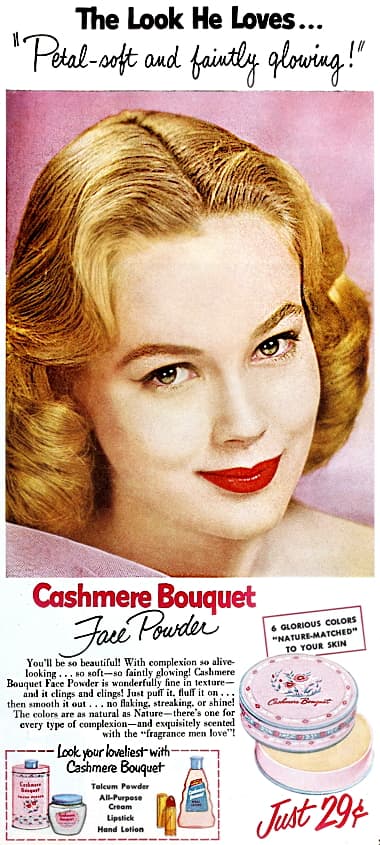
1953 Cashmere Bouquet.

The Colgate-Palmolive Building at 300 Park Avenue New York designed by Emery Roth & Sons. The company moved its headquarters here in 1956 after the building was completed.
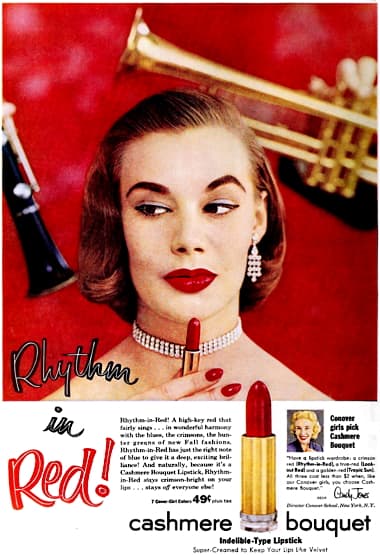
1955 Cashmere Bouquet Rhythm in Red Indelible-Type Lipstick.

1956 Cashmere Bouquet Inner Glow Lipstick.
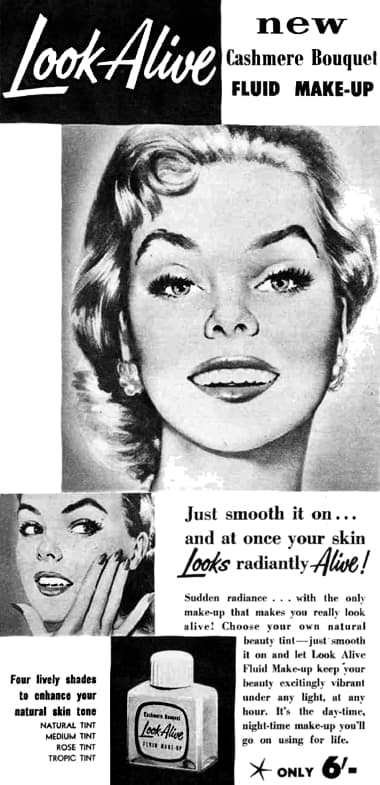
1957 Cashmere Bouquet Look Alive Fluid Make-up (Australia).
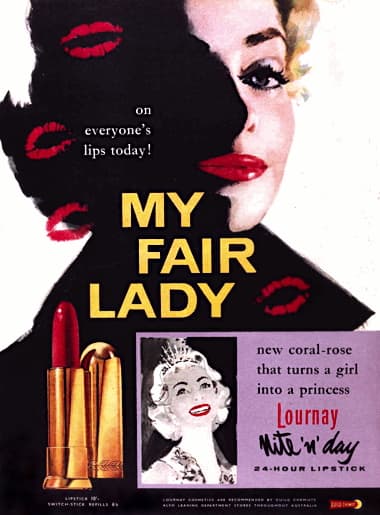
1958 Lournay Nite ‘N’ Day Lipstick (Australia).
